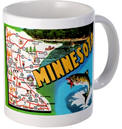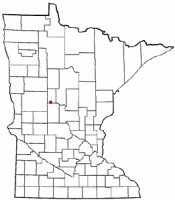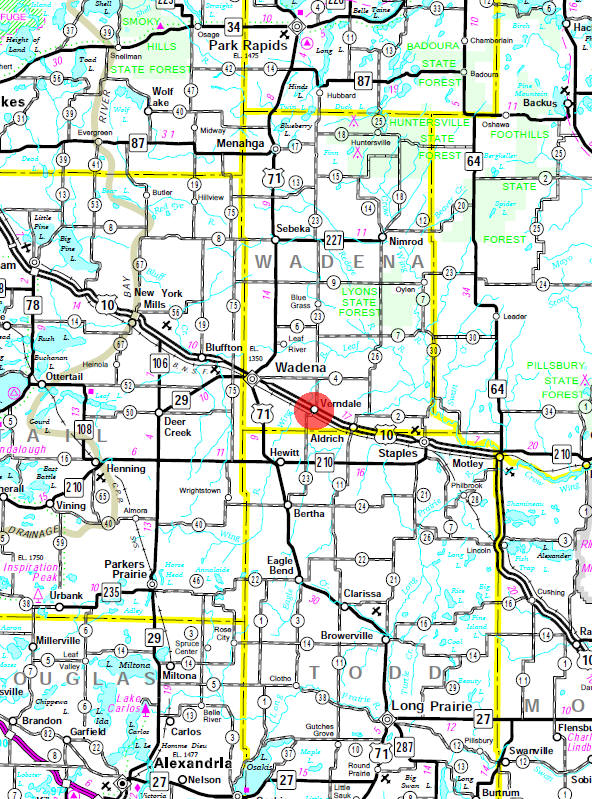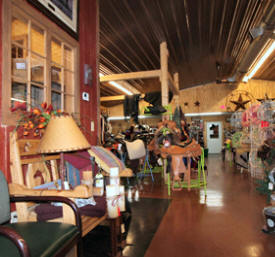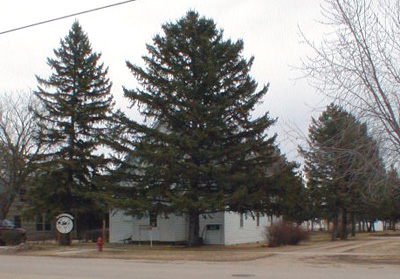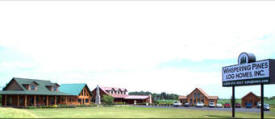Called "the most beautiful town site
along the Northern Pacific Railroad between Brainerd and
Fargo," the townsite of Verndale was situated one mile
east of the Wing River, on the edge of a beautiful
prairie which was sheltered on the north and west by
groves of small pines. To the south and east of the town
site was seen open prairie interspersed with small
groves, bounded in the distance by the dark line of the
Big Woods. In the vicinity of town there were three good
waterpowers on the Wing River. To the north of town were
extensive pineries. Verndale quickly became the
commercial center of the Wing River valley, a fertile
agricultural valley 20 miles long by five to six miles
wide.The first settlement in
the vicinity of Verndale was commenced by Capt. John E.
Butler, Charles W. Brown, John B. Kelly, and Charles C.
Kelly of Rock Falls, IA, in July of 1877. This group was
followed in September by Capt. C. C. Parker, Joseph
Sombs and others from the southern part of the state.
Many of Verndale's early settlers were Civil War
veterans. At one time, 100 Verndale families had one
member who was a Civil War veteran.
The honorable Lucas W. Smith settled
on a homestead claim near the town site and is credited
with building the first house at Verndale and engaged in
mercantile business. His business and home were located
on the north side of the railroad tracks. He was born in
Caledonia County, VT., September 15, 1816, and had come
to the Verndale area from Charles City, Pleasant Grove
Township, Floyd County, IA. The town site was first
settled in 1876 and was platted in 1877 in section 30 by
Judge Smith, with an addition in 1879 in section 19.
Judge Smith named the village in honor of his
granddaughter Helen Vernette "Vernie" Smith. Judge Smith
was the first postmaster when the post office was
established in 1878. In 1879, Judge Smith laid out his
addition to Verndale, north of the railroad tracks, in
Section 19 of Aldrich Township.
The first store was ready for business
in January 1878 and was opened by a grand New Year's
Ball. The first hotel, the Crandall House, was rushed to
completion in June of 1878. It opened July 3, 1878, as
soon as the roof was enclosed, to service the swarm of
land hunters. The Clark House hotel opened in September
of 1878 by G.H. Clark. The Commercial Hotel was also
constructed in 1878 by Henry Thompson.
The town of Verndale grew quickly with
the establishment of merchants and hotels to service the
swarm of settlers moving to the area. By 1878, according
to the Wadena County Tribune, which was published at
Verndale, the population had grown to 300 and the
countryside near the town was full of rapidly-developing
farm sites.
W.H. Raymond built a general supply
store on the south side of the railroad tracks, which
was later occupied by C. C. Parker & Co. In March of
1878, L.W. Farwell built a family residence and
established a lumber yard. By 1880, the Farwell
residence had been sold to Dr. H.J. Harding as a drug
store. Col. C.E. Bullard, of Eau Claire, WI, soon
erected a good and substantial building near Farwell's
and established himself in the sale of agricultural
implements and farm machinery. In May, A.A. Amidon, of
Farmington, MN, erected a handsome building for a store
and dwelling, opposite Mr. Raymond's site. In June, E.L.
Ingalls built the first blacksmith shop, which he sold
to John E. Butler in the summer of 1880, at which time
the business became "Bullard and Butler."
In 1878 and 1879, the Todd County
Argus newspaper, Long Prairie, MN, frequently comments
on the number of covered wagons passing through Long
Prairie on the way to Wadena County in the vicinity of
Verndale.
An important Verndale pioneer was
Capt. C. C. Parker. Parker came from Iowa in 1877.
Parker operated C. C. Parker and Co. Pioneer Store and
was postmaster from August 26, 1878 until February 26,
1884. He was one of the group of Verndale residents who
built the Verndale Road through the wilderness to the
Shell Prairies. This group of industrious men was the
first to recognize that there would be considerable
economic advantage for Verndale to provide a route for
settlers heading to the fertile Shell Prairies of
Hubbard County, where bonanza wheat farms were being
established. Their efforts paid off, making the railhead
of Verndale and its merchants the unquestionable center
of commerce, supplying the settlers with the goods they
needed to establish their homesteads and providing a
convenient place for them to ship their produce to
market. Capt. Parker also was among a group of Verndale
business men who attempted to get a railroad built
between Verndale and Shell City. While a representative
to the Minnesota House of Representatives in 1883,
Parker was instrumental in introducing legislation for
the establishment of Hubbard County and making Park
Rapids its county seat.
Being an important rail head for
shipping wheat, Verndale had two grain elevators. The
grain elevator east of the train depot, owned by Barnes
and Tenney, was constructed about 1879. This elevator
was later purchased by Mr. Andrews. Moses Stewart, Jr.,
a pioneer and early banker (Bank of Verndale), built a
grain elevator in 1882, west of the train depot. Bert
and Al Pettit who came from Iowa in 1879 and 1880,
respectively, later purchased Mr. Stewart's elevator and
started the Pettit Grain and Potato Company, which
became a large and important business in Central
Minnesota. The company was headquartered at Verndale and
incorporated with B.H. Pettit, president; C.P. Pettit,
vice president; and L.H. Pettit, secretary and
treasurer. The Pettit Grain and Potato Company did an
annual business of about $400,000 and had elevators or
warehouses at Verndale, Leaf River, Wadena, Aldrich,
Philbrook, Hewitt, Parkton, Menahga, Henning, Sebeka,
Bluffton, New York Mills, Deer Creek, Park Rapids,
Battle Lake and Staples.
The town developed as a wheat trading
center for the county, and much of central Minnesota.
Having a grist mill, two grain elevators, a Northern
Pacific Railroad station and numerous merchants, made
Verndale a boom town and provided a distinct advantage
in commerce over neighboring communities. In 1881, the
Verndale railroad station did $3,092.12 in freight
business. And, in 1884, 200,000 bushels of wheat were
shipped from Verndale.
Settlers heading north to the fertile
Shell Prairies, in southern Hubbard County, Minnesota,
would travel by rail to Verndale, purchase their
supplies at local merchants and head 55 miles north into
the wilderness to their homesteads on the virgin
prairie. The bumper crops of wheat grown on these
fertile prairies brought a flood of homesteaders to the
prairies and prosperity to Verndale.
The First Grist Mill in Northern
Minnesota
In November of 1879, a community
meeting was held in the growing village of Verndale to
discuss what was needed to keep the community moving
forward. It was decided by the group that a grist mill
was most important for the continued growth and
development of the community. Word was put out through
advertisements for parties to come here to erect a grist
mill.
The plan worked, for in April of 1880,
Mr. E. M. Britts and Mr. S. S. McKinley of the Osage
City Mills, Osage, IA, came to Verndale to inspect the
area and selected a beautiful mill site on the Wing
River. The property was owned by T. C. Thompson.
Financial matters and rights of way were quickly settled
to make way for the mill. Construction of the mill was
quickly started and the facility was completed and
dedicated with a grand free dance on July 20, 1880. This
was the first mill of its kind in the northern part of
the state.
Mr. Britts hired Thomas C. Myers, also
originally from Osage, IA, to be the general contractor
on the mill, his crew of 25 men were quickly put to work
building the sturdy mill building. He was assisted in
building the dam by Charlie Ham who used his oxen to
help move the logs, which were used to construct the
dam.
As recorded in an 1881 survey of
Wadena county: "Verndale Flouring Mills, E. M. Britts &
Co., on the Wing River near the centre of section 18,
Aldrich, one and a half miles north of Verndale; three
run of stone; head, about twelve feet. This dam is
founded on the till, which is covered here by ten feet
of sandy and gravelly modified drift."
The mill was built into the hillside
on the east bank of the river. Power was delivered to
the mill by the use of a 100 foot belt, covered in a
wooden runway, which ran up the river bank from the
turbine waterwheel. This set up provided the mill with
125 horse power.
Mr. Britt's mill served area farmers
and the caravans of wagons which traversed the 55 mile
long Wheat Trail (Verndale Road) which ran from Shell
City to Verndale. Shell City, now a ghost town, was a
community on the Wadena and Hubbard county line, on the
edge of the vast Shell Prairies, near Park Rapids.
Farmers from the Shell Prairies brought their bumper
crops of wheat down the Verndale Road to have flour
ground at the mill or to ship their grain out by rail
from the Andrews or the Stewart (later Pettit) grain
elevators which were located on the Northern Pacific
Railroad tracks at Verndale. The caravans traveling to
Verndale often numbered as many as 100 wagons. It is
said that as much as 800,000 bushels of wheat were
shipped from Verndale at the peak of the wheat trade.
Verndale was the closest market for these farmers and
their business made Verndale a bustling and prosperous
trade center.
Although the history of the mill site
is incomplete, it is known that the first mill burned
and was replaced by a second mill, which had six roller
mills. This mill could grind 100 (196#) barrels of flour
per day, which were shipped to market by rail from
Verndale.
Mr. Britts ran the grist mill until
about 1900 when he left for Duluth to engage in the
business of banking; using the profits he had generated
running the mill at Verndale.
The mill dam also supplied electrical
power for Verndale. In 1903, an electric power plant was
installed and the lights were first turned on March 1,
1903. By 1906, the electric power plant had been moved
to the lower level of Verndale's vacant courthouse
building, which was destroyed by fire on January 5,
1912.
Other owners of the mill included:
John Greene, who was operating the mill in 1907. Mr.
Greene would grind 25 sacks of oats for $1.00. K.S.
Bagne was the miller in 1907. During the spring floods
of 1910, Mr. Bagne made an attempt to save the dam, but
his efforts failed and the dam was lost.
The story of Verndale's grist mill
ends on July 8, 1912, when lightning struck and
destroyed the mill, which had been standing idle for
several months.
Wadena County Seat Battle
Although the Wadena county seat battle
was simmering as early as 1879, it began to heat up in
1884. In that year, the citizens of Verndale built a
fine courthouse building at a cost of about $9,000 and
offered it to Wadena County as a gift, on condition that
within one year after its acceptance, the county seat
would be moved to Verndale. The county board did not
accept the gift.
Verndale's courthouse was a handsome,
Second Empire style structure erected on a 300' square
block of ground, bounded on all four sides by streets.
It was designed by Messrs. Marr and Richards of St.
Paul. The building was 42' x 62', two stories high,
topped with a handsome iron mansard roof and tower. Full
height of the building to the top of the tower was 67'.
The walls were entirely made of brick, the first story
17" thick and the second 13" thick. The first floor
contained offices for the auditor, treasurer, clerk of
court, register of deeds, and superintendent of schools.
The second floor furnished a courtroom, grand jury room
and sheriff's office (together), a jury room and small
counsel chamber. The third floor, within the mansard
roof, was to supply additional jury rooms, or other uses
for future expansion needs.
Wadena matched the offer and a battle
between the cities began. An election was held in 1886
to determine the matter. Both villages were said to have
hired men to remain in their respective voting precincts
30 days prior to the election. The outside "voters"
practically ran both villages and it was considered
unsafe for women to go out on the streets. In November,
the voters went to the poles and Wadena won the election
by 474 votes. The normal voting population of each
village at the time was approximately 300, but when the
votes were counted, each town went considerably over the
1,000 mark. Verndale was never pleased with the manner
in which Wadena went about securing the vote, counting
the ballots in secret, and the result was protested to
the Minnesota Supreme Court. In August of 1887, the
Minnesota Supreme Court handed down a decision in favor
of Wadena; thus, the matter was settled and the county
seat was retained at Wadena.
Following the county seat battle, a
group of nuns from St. Cloud, MN, opened a Catholic
academy in the building. The academy opened in 1892, but
closed in 1894 from a lack of support by local
Catholics. Later, the building's second floor was
remodeled into an opera house and the lower level was
fitted with an electric powerhouse to generate
electricity for the town. On January 5, 1912, the engine
room caught fire and the Verndale courthouse building
burned.
Because many of the early businesses
were constructed of wood and built close together, fire
was a major concern for many pioneer towns. Once a
building was ablaze, there was little the local fire
fighters could do, but try to save what contents could
be stolen away from the flames. Several times fires have
destroyed the business section of Verndale, but the
industrious business owners, more often than not,
rebuilt on the ashes of the old structures. In October
of 1898, nine businesses were lost to flames on the west
side of Farwell Street. In 1905, the bowling alley
caught on fire. Another major fire destroyed five
buildings on the west side of Farwell Street in 1906. In
1922, the two-story Dickinson Block burned; this was
Verndale's largest brick store and it was located on the
SE corner of Farwell Street and 1st Ave. S.
Verndale School
In 1878, the community built a
handsome brick school building just south of the village
and Miss. Cora Butler was employed as the first teacher.
Two more teachers were hired for the Fall and Winter
terms. By the Fall of 1880, 50 students were enrolled at
the Verndale School. S.L. Frazier came from Wisconsin in
1881 to become principal of the Verndale school. The
original school building burned in May 1915 and a new
structure replaced it in 1916.
An addition was made to the 1916
structure in 1936 including a gymnasium/auditorium
(seating 700) and additional classroom space. Another
addition, to the rear, was competed in 1954. This
addition provided classroom space for grades one through
six. In 1965, a large addition added a new gymnasium,
classroom space, and industrial shop area to the
building. In the 1990s, the original 1916 building was
demolished to make way for a new addition, which was
added to the front of the building.
From
Wikipedia, the free encyclopedia
Additional Verndale
historical information and photos can be found at:
www.verndalemn.com
|
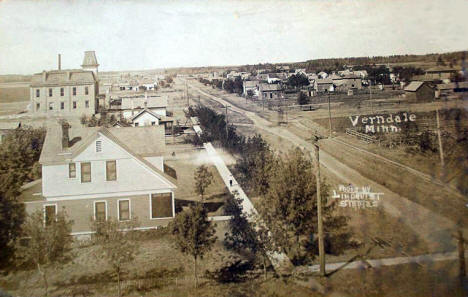
Street scene, Verndale Minnesota, 1900s
LakesnWoods.com Postcard and Postcard Image Collection- click image to enlarge
Visit
The
Verndale Photo Gallery for more recent and
historic area photos |


